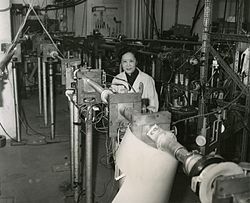Chien-Shiung Wu
Chien-Shiung Wu (Chinese: 吳健雄; May 31, 1912 – February 16, 1997) was a Chinese-American particle and experimental physicist.
Early life
Wu was born in May 1912 in Liuhe, a small town near Shanghai. Wu Zhongyi, her father, participated in the 1911 revolution against the Chinese Manchu dynasty. He was the founder of an all girls’ school in China. Educating girls wasn’t seen as important at that time. Wu went to that school until she was nine. After that, she went to the Soochow Girls’ School. She graduated in 1930. She was the best student in her class.
Studies
Wu went to college at Nanjing University. She studied physics there. She graduated in 1934. She spent one year teaching in a university. A year later, she went to study X-ray crystallography, which is the study of crystals. She did so at the National Academy of Sciences in Shanghai. A woman scientist who she worked with told her to go to study in the United States. She said this because China didn’t have a very good physics program. With the help of her rich uncle, she sailed to America in 1936.
Work
Wu started working on nuclear physics with a particle physicist named Ernest Livermore. She helped Emilio Segre. He won a Nobel Prize years later. During the same time, Japan invaded China. She didn’t hear from her family for years. She kept working.
Wu also studied the electromagnetic energy a particle gives off when it slows down. She also studied what happens when a uranium nucleus splits. For her work, she got a PhD in 1940. She became known as an expert on fission, which is the splitting of atoms.
She studied theories about atoms developed by Enrico Fermi. She ended up confirming one of his theories.
Wu continued with her work in physics in her later career. She faced a difficult hypothesis involving beta decay in 1963. Beta Decay was discovered by Richard Feynman and Murray Gell-Mann.
Disproving Parity
Chien-Shiung Wu helped overthrow the law of conservation of parity along with Tsung Dao Lee and Chen Wing Yang. For 30 years, parity was a universal law. The theory states that parity was when an event and its reflection were the same. Scientist believed that the conservation of parity applied to all events. Chien-Shiung Wu helped to disprove this theory. She found this when studying the electrons at a low temperature. Wu did most of the work. The Nobel Prize committee did not acknowledge her. They did recognize her two male partners who won the award.[1][2]
Achievements
Many considered Wu's work on Fermi’s theory worthy of a Nobel prize. Her work was important but did not qualify for the prize. The two scientist she worked with on the theory about parity won a prize and she did not. People believed her work was not original.
She became the first woman to be the president of the American Physical Society. She was the first woman to receive the Comstock Award from the National Academy of Sciences. She was also the first woman to receive the Research Corporation Award. She received honorary degrees from over a dozen universities. Yale, Princeton and Harvard were some of the universities that recognized her work. Princeton gave her an honorary doctorate of science. She became the first woman to ever receive that.
Personal life
Wu married Luke Yuan in 1942. She taught at Smith College in Massachusetts. After that, she taught at Princeton. In 1944, she was recruited to do top-secret work on radiation detectors for the atomic bomb project called the Manhattan Project at Columbia University. She worked in a secret facility.
After World War II, Wu heard back from her family. They had all survived.
Wu retired in 1981. She died of a stroke on February 16, 1997, in New York. She was 86 years old. Her ashes were buried in the courtyard of her father's school.
Wu was an inspiration and a trailblazer. She didn’t let racism or sexism put her down. She kept working hard. She made some amazing discoveries. Her work wasn’t credited with a Nobel Prize but she made a huge impact on the world's knowledge of fission and quantum physics.
Chien-Shiung Wu Media
Chien-Shiung Wu Memorial Museum, Southeast University.
Wu (right) in an outing with Margaret Lewis in Berkeley, California
Chien-Shiung Wu and Luke Yuan (left) at the home of Mr. and Mrs. Robert Millikan (right) on their wedding day
Mao Zedong and Chiang Kai-shek would fight for the fate of the country immediately after the united Chinese forces won the Second World War.
Chien-Shiung Wu (left) with Wallace Brode (right) at Columbia University in 1958
Related pages
References
- Cao, Tian Yu. "Wu, Chien-shiung." World Book Student, World Book, 2017, www.worldbookonline.com/student/article?id=ar611370. Accessed 28 Mar. 2017.
- "Chien-Shiung Wu." Asian American Reference Library, edited by Helen Zia, et al., 2nd ed., UXL, 2004. Student Resources in Context, link.galegroup.com/apps/doc/EJ2131100035/SUIC?u=palo88030&xid=894bcb8b. Accessed 28 Mar. 2017.










